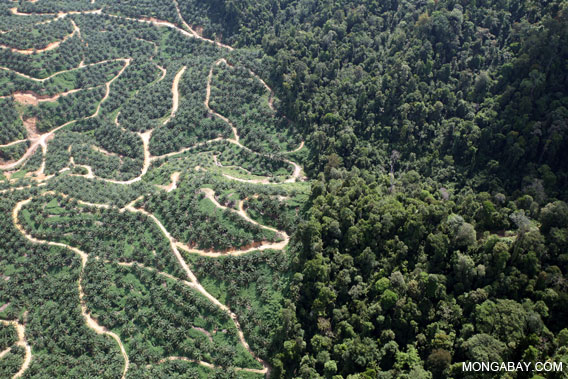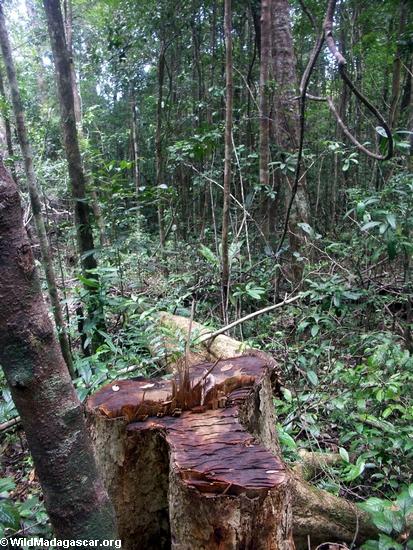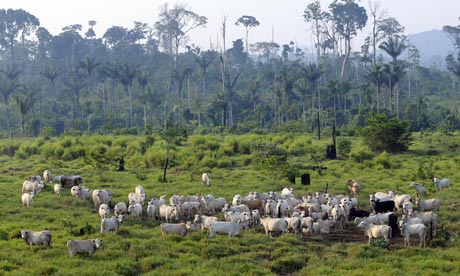As mentioned in some of my previous posts with the
changes of forest cover, major services delivered by the rainforest ecosystem
are affected negatively such as the regulation of the climate, the storing of
carbon, the supply of water and the highest biodiversity richness that
describes the biome (J. A. Foley et al., 2005). So why do people keep deforestation rainforests in an unsustainable
manner?
On a global scale, deforestation is responsible for an
80% loss of previously forested land. Deforestation is the main threat to
rainforests around the world. An astounding 90% of the rainforest in western Africa
has been lost due to deforestation since the 19th century. The rainforests
in the other 2 major regions (South America and South Eastern Asia) have also
been destructed by deforestation (WPF).
The causes of Deforestation are similar across the
world. Bjorn Lundgren (1985) pointed out that at a national level, people need
to clear new land for agriculture and wood for various purposes. Nonetheless, subsistence
farming accounts for a small portion of the rainforest destruction. Most of
deforestation occurs for commercial agriculture such as the conversion of rainforest
to Palm Oil (Figure 1) plantations in Southeast Asia and the soybean plantations in the
Amazon basin.
 |
| Figure: Oil palm plantation adjacent to native rainforest (TBP) |
Logging (Figure 2) has an important role in forested land loss. Even
though it was designed to be a sustainable way of harvesting trees in most
cases it is not true. In Southeast Asia, there is a high number of tree species
that can be logged (10-20 /ha) leaving a heavily destructed ecosystem with this
practice. In addition to this logging can have collateral damage to the rainforest
by clearing some spaces for the tracks and platforms (Y. Malhi et al., 2013).
 |
| Figure 2: Tree felled (illegal logging) in Masoala National Park, Madagascar (WildMadagascar) |
In the South American rainforests one of the primary
cause of deforestation is the clearing of land for cattle pasture or as some
may call it ‘hamburger ranches’ (Figure 3). The Brazilian Amazon was reduced in forested
land by 38% from 1966-1975 for cattle ranching. By 2003 Europe’s imports of processed
meat was 74% from Brazil from which 80% was coming from the Amazon (R. A.Butler, 2010). In 2010 the extent of deforestation in the Brazilian Amazon reached
the area of 740 000km2 (M. Egler et al., 2013).

Figure 3: Brazilian beef barons claim to be protecting Paraguay's Indian lands – by turning them into ranches (theguardian)
Deforestation methods include the process of ‘slush
and burn’ which is the cutting of trees in addition to burning them to reduce
to clear the land. These localised fires may sometimes escape their original
plot resulting to devastating effects by reducing the forested land and
hindering local activities due to the black smoke (R. A. Butler, 2010).
Other causes of deforestation include open cast mining (Figure 4)
where large areas of forest were cleared for their subsistence, fuel wood and
building material (Amazon Basin 1980s) (R. A. Butler, 2010). Colonisation has
also played an important role in the well-being of rainforests. Vast areas of
rainforests across the world where exploited by the arrival of the invaders.

Figure 4: Explosion at a mine in
the Amazon Rain Forest, Ecuador (ConstructionPhotography)
The map on Figure 5 shows the change in forested areas over
the period of 2000-2012. The area of the tropics exhibit the loss forest at the
rate of 2101 km2/yr. A reduction in deforestation was observed in Brazil
but the increasing loss of forest in other countries around the world offset
this reduction (M. C. Hansen et al.,2013) You can use the software to look in to the areas in more detail here.
Figure 5: The map shows forest change from 2000-12. Green areas are forested; red suffered
forest loss; blue showed forest gain; pink experienced both loss and gain (BBC)
It is estimated that there is a linear relationship with deforestation
and economic growth. There is some hope that with different environmental
policies deforestation will be reduced (J. Hargrave & K. Kis-Katos, 2013) In my next post I will be discussing
the effects of deforestation.

Wonderful post, Nikol - One point. Many local people despair of the destruction being wrought by palm oil farming, for e.g. in West Sumatra and Riau, local people have opposed nearly all palm oil companies’ operations through collective action. Many communities have organised protests which call on local governments to defend community members’ rights to land taken over by palm oil companies. Protests began in the early 1980s, when local officials were cooperating with companies to compel communities to relinquish land for plantation development. Under pressure, protests subsided or were effectively suppressed for over a decade, but have mushroomed since President Suharto resigned in mid-1998. Many conflicts have festered for years.
ReplyDeleteHello Michelle,
Deletethank you for your input. Deforestation does not only have an effect on the environment and the climate, but also societal effects to the local people where their livelihoods are dependent upon that ecosystem. I will have this in mind for my next post where I will be discussing the effects of deforestation.